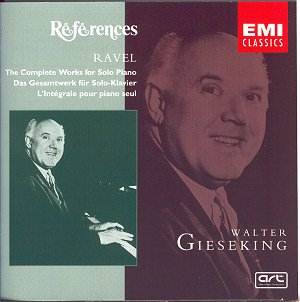For a pianist so associated with the French repertoire
it’s somewhat perplexing to find that these Ravel recordings have been
out of the domestic catalogue for so long. His Debussy set, currently
on EMI CHS 5 658552, has always occupied a central place in the discography
– as Bryce Morrison says in his notes Gieseking is to Debussy as Schnabel
is to Beethoven or Rubinstein to Chopin - whereas his sovereignty in
Ravel seems to have been very slightly eroded over the years. Which
again, if true, is a matter for bewilderment. Whilst other pianists
may sometimes bring greater clarity of articulation to Ravel or a greater
elegance very few can command the myriad exquisite nuances that constantly
illuminate the music in the way Gieseking invariably does.
In the Menuet antique, one of Ravel’s first published
piano works, we are introduced to his unique brand of piquant antiquarianism,
a trait he was never to lose, visiting the past and vesting it in new
garb. And in the Pavane pour une infante defunte we can hear Gieseking’s
extraordinary pedalling subtleties and characteristic pearl drop tone;
at 3.25 he creates a heavily pedalled wash that magically ushers in
the right hand line. The gradations of tone throughout the range are
fabulously exact and never calculated. Jeux d’eau is rapidly played.
The River God is certainly laughing at the water here – and Gieseking’s
fleetness is sometimes to the detriment of clarity of articulation even
though it is unavoidably true to say that his occasional technical shortcomings
are seemingly subsumed into the greater whole.
It is in fact remarkable that his two years with Karl
Leimer were the extent of his official studies; his famous comment that
"talent goes in inverse ratio to the necessity for practice"
might otherwise be seen as an ignoble boast were it not for his laconic
truthfulness and the fact that his sensibility was never obviously virtuosic
but one of the heightened poetic. In the archaisms of the Sonatine (1903/5)
Gieseking’s second movement is stately – with bass notes staccato and
ineffably wry – and at 2.59 he opens out his pedalling, terracing the
final chords’ dynamics, animated by his remarkable ear for apposite
sonorities. The nonchalant flourish at the end of the Anime movement
is another feature of his craft and perfectly judged. Miroirs is not
immaculately played but it is so evocative and supremely imaginative
that the imperfections are of little significance.
If there is some over-pedalling in Une barque sur l’ocean
(and the tempo is really too fast for the succeeding thematic relationship
to work) and if the two glissandos in La vallee des cloches are excitingly
but not always audibly played, what is that against so much that is
supreme? In Noctuelles those passages frequently fudged by other pianists
are triumphantly clear. In Oiseaux tristes the middle voices are brought
out in perfect gradation – tonally this is playing of the greatest imagination
and technical resource. Gieseking’s rhythm in Une barque propels the
chopping rhythm onward with torrents of ascending and descending runs
under great control. Right hand flourishes are coolly tossed off in
Alborada del gracioso and even more magnificent are his repeated notes
here – quiet, fast, even and tremendously difficult to accomplish. The
tonal weight at 4.02 in La Vallee des cloches is exquisite – this is
truly a transfiguration.
In Gaspard de la nuit Gieseking plays up the contrasts
of volume and tempo – listen for example at 5.30 – and within a seemingly
constricted compass he conjures up magical colouristic inflections.
The fast passagework (maybe too fast for optimum comfort) with lots
of pedal is a galvanizing and macabre triumph. The little Haydn piece
dates from 1909, the centenary of his death. Ravel’s admixture of tribute
and harmonic piquancy is winningly done. The Schubertian tribute – the
Valses nobles et sentimentales – caused bafflement on first hearing
but Gieseking has their full measure. He brings insouciant whimsy to
the Assez anime movement (No 4) and is never too fast for coherent articulation
in the rapid movement Vif (No 6). His rhythm is always alive and animated,
his tone wonderfully complex. The lightly parodic "In the style
of…" are witty little pastiches of Borodin and Chabrier – and,
at under two minutes each, succinct.
Le Tombeau de Couperin, one of the cornerstones of
the French pianistic repertoire, is made for Gieseking. His rapid wit
is accentuated in the Prelude with the use of unusually light pedalling.
The Fugue is eventfully played – softened tone, even production, though
perhaps with not quite the level of dynamic variety one would wish for.
In Forlane, a five-minute Allegretto, his clarity never descends into
artificiality or disengagement – on the contrary, this is pianism of
immense contrast and life. It is not the only way to play Ravel – what
could be – and contrasts with the perhaps more centrally French playing
of, say, Robert Casadesus or Marcelle Meyer, both of whose impulses
were rather more aloof than Gieseking’s. But there can be no greater
compliment than to say of a performance that during its span one is
convinced that the music could go no other way. And that is Gieseking’s
Ravel.
Jonathan Woolf


